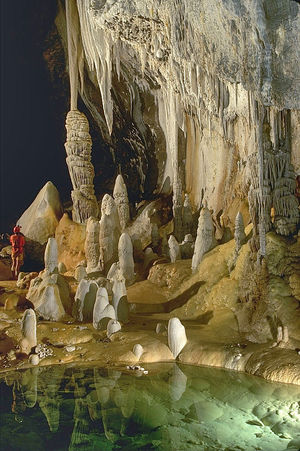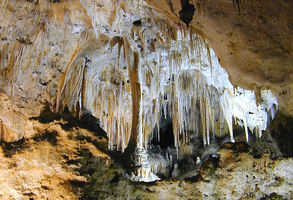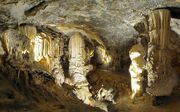Stalactite
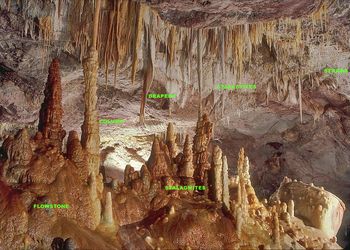
A stalactite (UK: /ˈstæləktaɪt/, US: /stəˈlæktaɪt/; from the Greek stalasso, (σταλάσσω), "to drip" and meaning "that which drips") is a type of speleothem (secondary mineral) that hangs from the ceiling of limestone caves. It is a type of dripstone.
Contents |
Formation and type
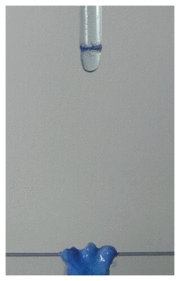
Stalactites are formed by the deposition of calcium carbonate and other minerals, which is precipitated from mineralized water solutions. Limestone is calcium carbonate rock which is dissolved by water that contains carbon dioxide, forming a calcium bicarbonate solution. The chemical formula for this reaction is:[1]
-
- CaCO3(s) + H2O(l) + CO2(aq) → Ca(HCO3)2(aq)
This solution travels through the rock until it reaches an edge and if this is on the roof of a cave it will drip down. When the solution comes into contact with air the chemical reaction that created it is reversed and particles of calcium carbonate are deposited. The reversed reaction is:[1]
-
- Ca(HCO3)2(aq) → CaCO3(s) + H2O(l) + CO2(aq)
An average growth rate is 0.13 mm (0.005 inches) a year. The quickest growing stalactites are those formed by fast-flowing water rich in calcium carbonate and carbon dioxide, these can grow at 3 mm (0.12 inches) per year.[2]
Every stalactite begins with a single mineral-laden drop of water. When the drop falls, it leaves behind the thinnest ring of calcite. Each subsequent drop that forms and falls deposits another calcite ring. Eventually, these rings form a very narrow (0.5 mm), hollow tube commonly known as a "soda straw" stalactite. Soda straws can grow quite long, but are very fragile. If they become plugged by debris, water begins flowing over the outside, depositing more calcite and creating the more familiar cone-shaped stalactite. The same water drops that fall from the tip of a stalactite deposit more calcite on the floor below, eventually resulting in a rounded or cone-shaped stalagmite. Unlike stalactites, stalagmites never start out as hollow "soda straws." Given enough time, these formations can meet and fuse to create columns.
Stalactites can also form in lava tubes, although the mechanism of formation is much different.
Concrete

Stalactites can also form on concrete, and on plumbing where there is a slow leak and limestone (or other minerals) is in the water supply, although they form much more rapidly there than in the natural cave environment (description and experiments see literature).
The way stalactites form on concrete is due to different chemistry than those that form naturally in limestone caves and is the result of the presence of calcium oxide in concrete. This calcium oxide reacts with any rainwater that penetrates the concrete and forms a solution of calcium hydroxide. The chemical formula for this is:[1]
-
- CaO(s) + H2O(l) → Ca(OH)2(aq)
Over time this calcium hydroxide solution reaches the edge of the concrete and, if the concrete is suspended in the air, for example, in a ceiling or a beam, then this will drip down from the edge. When this happens the solution comes into contact with air and another chemical reaction takes place. The solution reacts with carbon dioxide in the air and precipitates calcium carbonate.[1]
-
- Ca(OH)2(aq) + CO2(g) → CaCO3(s) + H2O(l)
When this solution drops down it leaves behind particles of calcium carbonate and over time these form into a stalactite. They are normally a few centimeters long and with a diameter of approximately half a centimeter.[1]
Records
The White Chamber in the Jeita Grotto's upper cavern in Lebanon holds an 8.2 meters stalactite which is also accessible to visitors and is claimed to be the longest stalactite in the world. While it has been claimed that the longest stalactite known hangs in the Chamber of Rarities in the Gruta Rei do Mato (Sete Lagoas, Minas Gerais, Brazil) and is 20 metres long, vertical cavers have often encountered longer stalactites while exploring. One of the longest stalactites viewable by the general public is in Doolin Cave, County Clare, Ireland, in a karst region known as The Burren, what makes it more impressive is the fact that the stalactite is held on by a section of calcite less than 0.3 square meters.[3]
Origin of the term
Stalactites are first mentioned (though not by name) by the Roman natural historian Pliny in a text which also mentions stalagmites and columns and refers to their creation by the dripping of water. The term "stalactite" was coined in the 17th century by the Danish Physician Ole Worm who created the word from the Greek root stalasso, (σταλάσσω), "to drip".
Photo gallery
 Water droplet coming out of the central canal of a stalactite. |
 Stalactite in Doolin Cave, Ireland measuring 20ft (6.54m) long. |
 Mineralized water drop forming at bottom of stalactites. |
 Stalactites of the type called "soda straws" from the Choranche caves in the Vercors, France |
See also
- Stalagmite
- Lavacicle
- Rusticle
- Karst
- Icicle
References
- ↑ 1.0 1.1 1.2 1.3 1.4 Braund, Martin; Reiss, Jonathan (2004), Learning Science Outside the Classroom, Routledge, pp. 155–156, ISBN 0415321166
- ↑ Kramer, Stephen P.; Day, Kenrick L. (1995), Caves, Carolrhoda Books (published 1994), p. 23, ISBN 9780876144473
- ↑ "Caves With The Longest Stalactite". http://www.showcaves.com/english/explain/Statistics/Stalactites.html. Retrieved 2008-06-11.
- Dripstone in time-lapse ("Tropfsteine im Zeitraffer") - Schmidkonz, B.; Wittke, G.; Chemie Unserer Zeit, 2006, 40, 246. doi:10.1002/ciuz.200600370
External links
- The Virtual Cave's page on stalactites
- "Stalactites" by Enrique Zeleny, Wolfram Demonstrations Project.
|
|||||||||||||||||||||||||
